Ever wondered which wood makes the best axe throwing target? From durability to self-healing properties, the right choice may surprise you. Read on, your ultimate guide awaits!
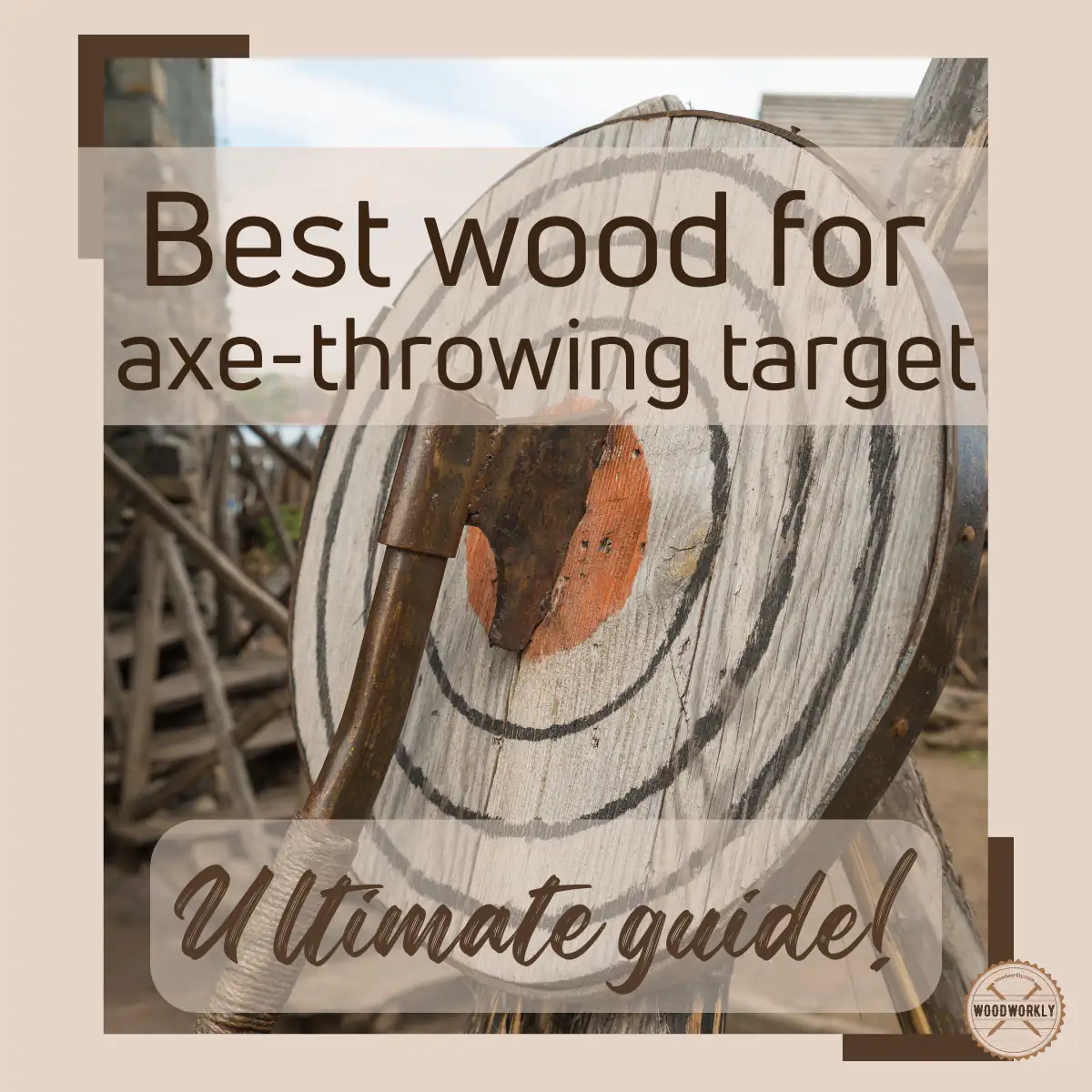
Axe throwing is a fast-paced sport and an enjoyable hobby for any age group. By making an axe throwing target, you can take the game to the next level.
When I became interested in axe throwing as a hobby, I wondered about the types of wood that could be used for an axe-throwing target.
After conducting some research, I was able to find best wood for axe throwing.
So, Here’re the 8 best wood for axe throwing target,
- Poplar
- Cottonwood
- Pine
- Willow
- Spruce
- Cedar
- Palm
- Douglas Fir
So, in this article, I’ll deeply discuss the best wood for axe throwing target with the pros and cons of each type of wood.

I’ll discuss their unique characteristics and how they differ from other woods which make them ideal for axe throwing target.
Also, I’ll talk about woods you should avoid using as an axe throwing target, and how to select the best wood on your own and have fun of it.
So, let’s get going!
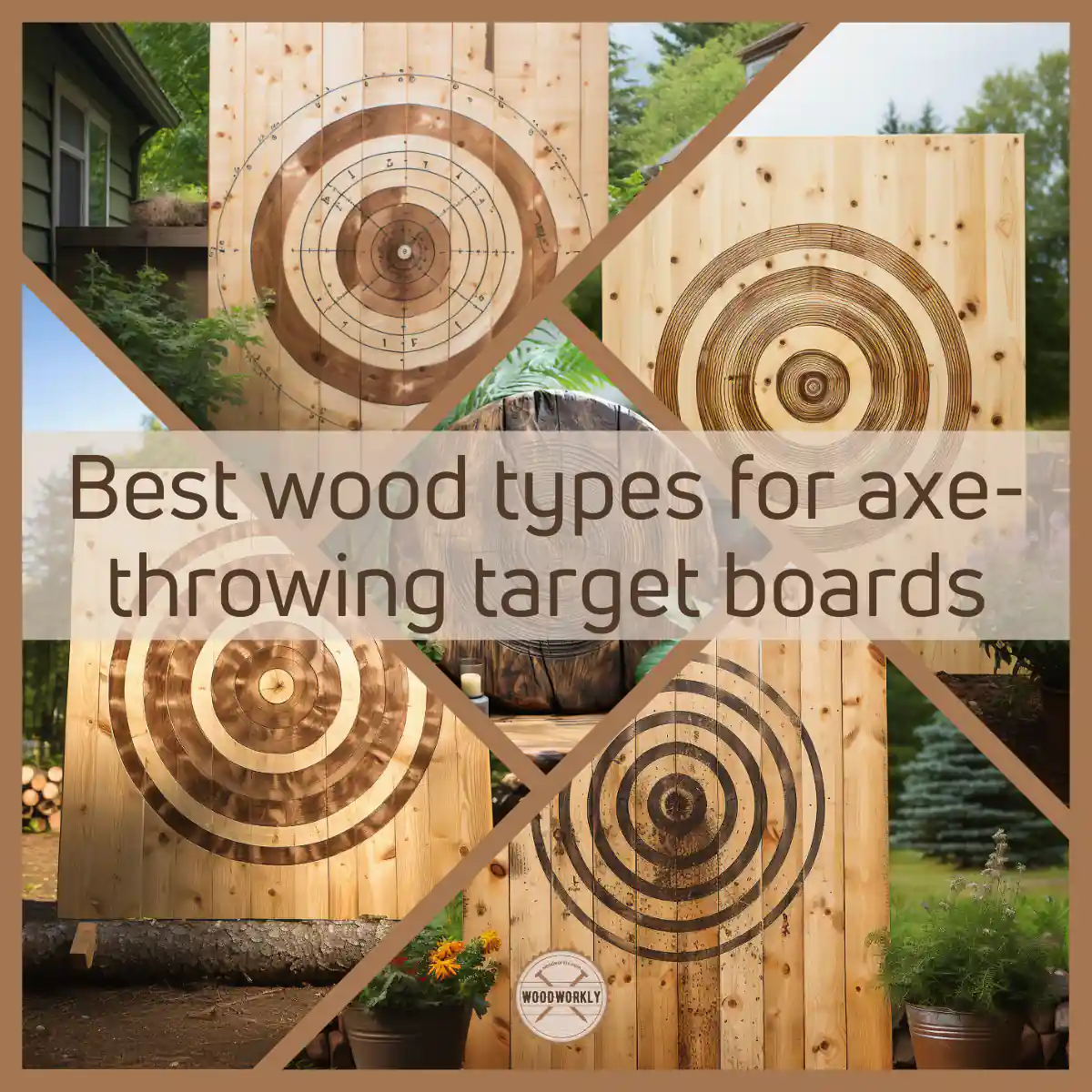
1. Poplar
Poplar is considered a common and popular wood for axe throwing target because of its very smooth surface and being a non-resinous wood.
Here’re some qualities of Poplar wood that make it perfect for axe throwing target,
- Self-healing wood
- Axe stick easily
- High durability
- Strong wood
So, let’s discuss each of those qualities of poplar wood which are important to use as axe throwing target in detail.
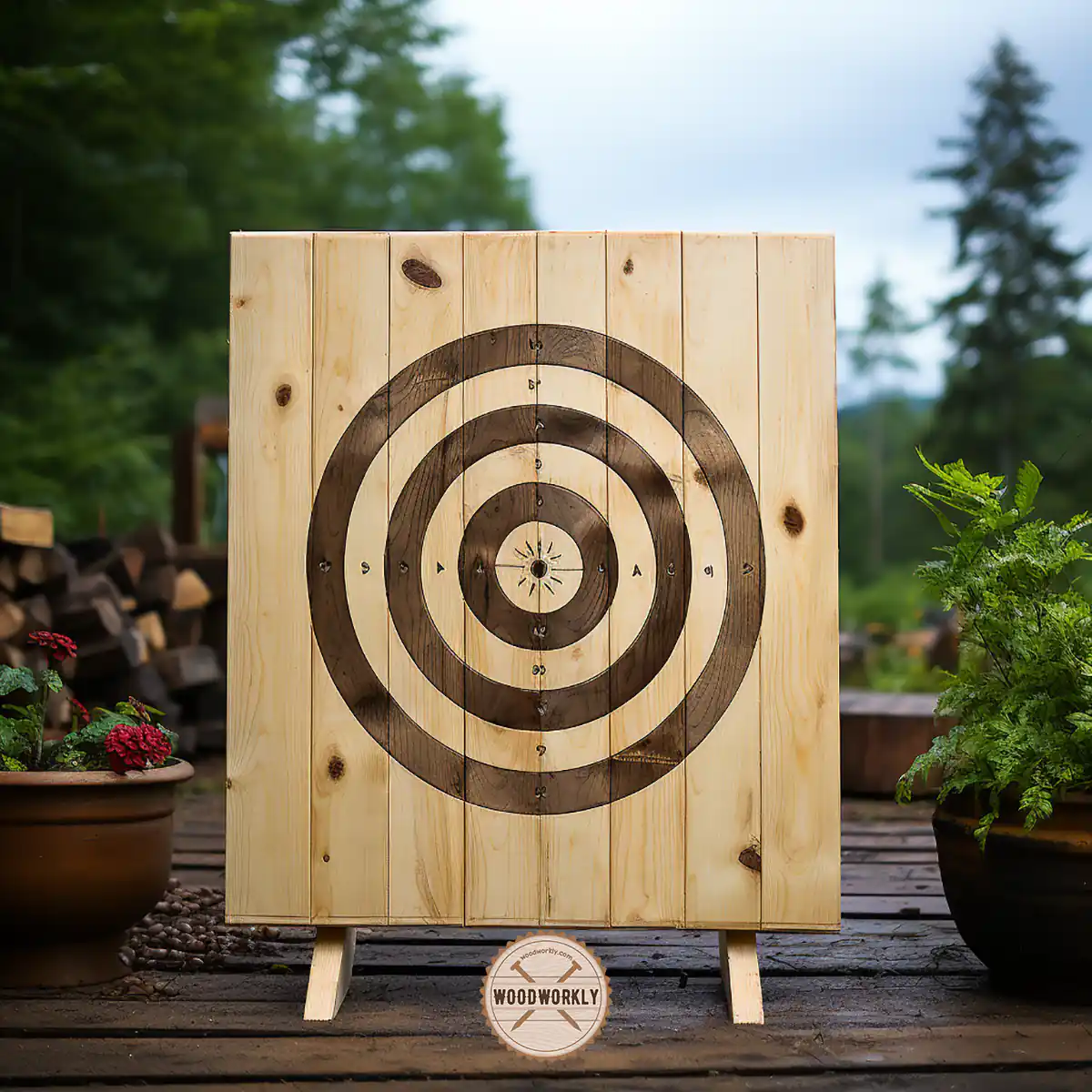
Self-Healing Wood
Poplar is softwood with self-healing capabilities which is so useful to use as axe throwing target material.
Poplar wood is soft and forgiving. Once the axe hits, the Poplar board tends to fill the holes marks and move back to its original position when the axe is removed.
The self-healing property of Poplar is important to keep your axe throwing target fresh as new for a long time.
Axe Stick Easily
Poplar wood is a straight grain wood with a uniform texture. Axe edge can easily go through its wood grain.
Therefore, in Poplar wood axe will stick nicely and easily. You don’t need to put much effort in order for the axe to stick.
High Durability
Poplar axe throwing target will easily last longer 4 to 7 times longer than normal dry boards like a bullseye.
Because of having good strength Poplar axe throwing targets can use for both outdoor and indoor use.
Pros and Cons of Using Poplar Wood For Axe Throwing Target
Here are the summarized details about the pros and cons of Poplar for making axe throwing target.
| Pros | Cons |
| Self-heal holes and scratches | Easily split |
| Axe stick nice and easy | No moisture resistance |
| Can use indoor and outdoor both | Can get mold easily |
| Uniform attractive texture |
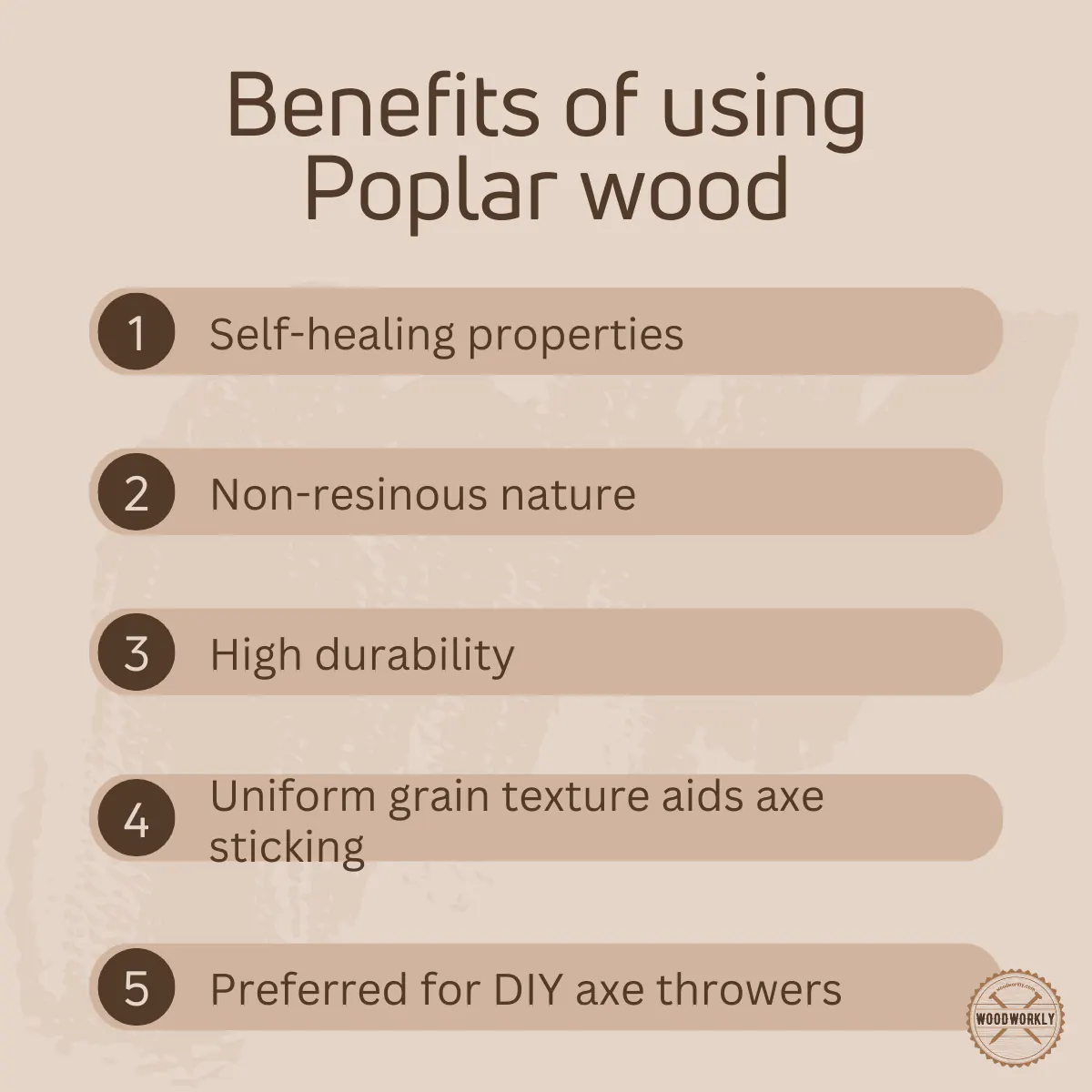
2. Cottonwood
Cottonwood is undoubtedly one of the best woods for axe throwing targets.
It is a softwood with many unique qualities that are preferable for making axe throwing targets.
Here’re some qualities of Cottonwood that make it perfect for axe throwing target,
- Self-healing wood
- High durability
- Axe stick easily
- Soundproof
Let’s discuss each of those qualities of cottonwood in depth
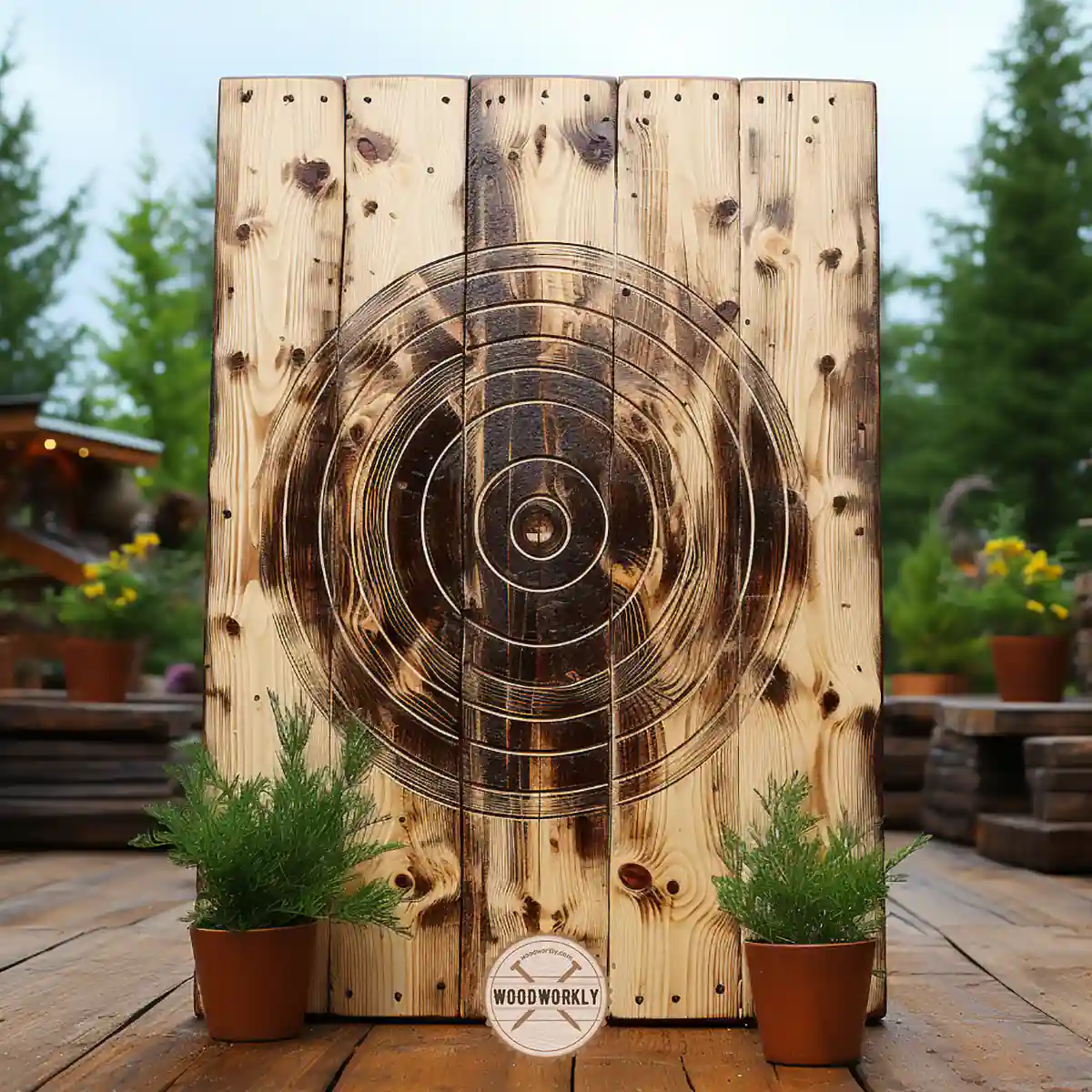
Self-Healing
Cottonwood is able to abord moisture from the outside world and act like self-healing material.
Holes that make on Cottonwood due to axe edges will seal up quickly as soon as once the axe is removed.
High Durability
Cottonwood lasts longer than most other types of woods, including Pine.
By making an axe throwing target using Cottonwood end grain it will last longer and have resistant to splitting or cracking.
Axe Stick Easily
Because of being a softwood with straight grain, the axe will easily go through fibers without splitting the wood. Even a little effort is well enough to stick deeply on Cottonwood.
If you’re a beginner in axe throwing, Cottonwood is best. It gives satisfaction and the workability is also higher than hardwoods.
Soundproof
Cottonwood absorbs moisture and water molecules are trapped inside of the fibers. Water has natural shock resistance and soundproofing ability.
Therefore, when the axe hits hard on the Cottonwood axe throwing target, it makes less noise because of having high water content inside the wood.
Cottonwood absorbs the shock and vibration and makes less noise.
This is important for people who like to axe throwing without making much noise level.
You’ll be able to keep the concentration because of its soundproofing properties.
Pros and Cons of Using Cottonwood For Axe Throwing Target
Here’re some summarized pros and cons of Cottonwood that are important in axe throwing target making.
| Pros | Cons |
| Self-healing | Get mold so easily |
| Soundproofing ability | Less weather resistant |
| Axe sick easily | Can be allergic to some people |
| Great for beginners | |
| Beautiful appearance | |
| Straight wood grain | |
| Lightweight |
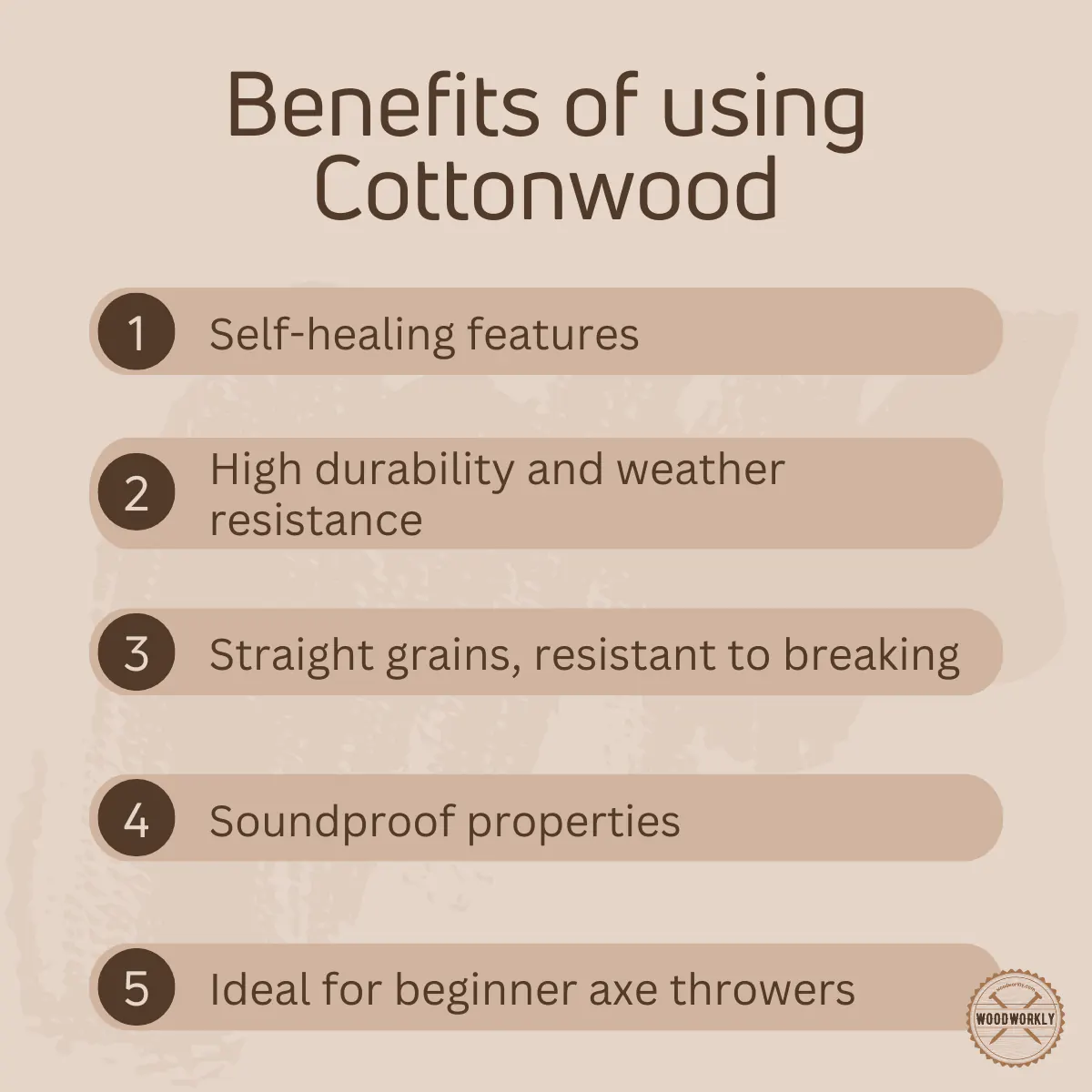
So, let’s talk about what makes Pinewood perfect for becoming one of the best wood for axe throwing target.
3. Pine
Pine is a good option for axe throwing target. Pinewood is not too strong or not too soft. That is what makes it special making it perfect to use as axe throwing target.
Here’re some qualities of Pine that are useful as axe throwing target material.
- Easy to work with
- High availability
- Strong wood
- Durable wood
Let’s discuss each of those qualities of pine in detail for axe throwing target making.
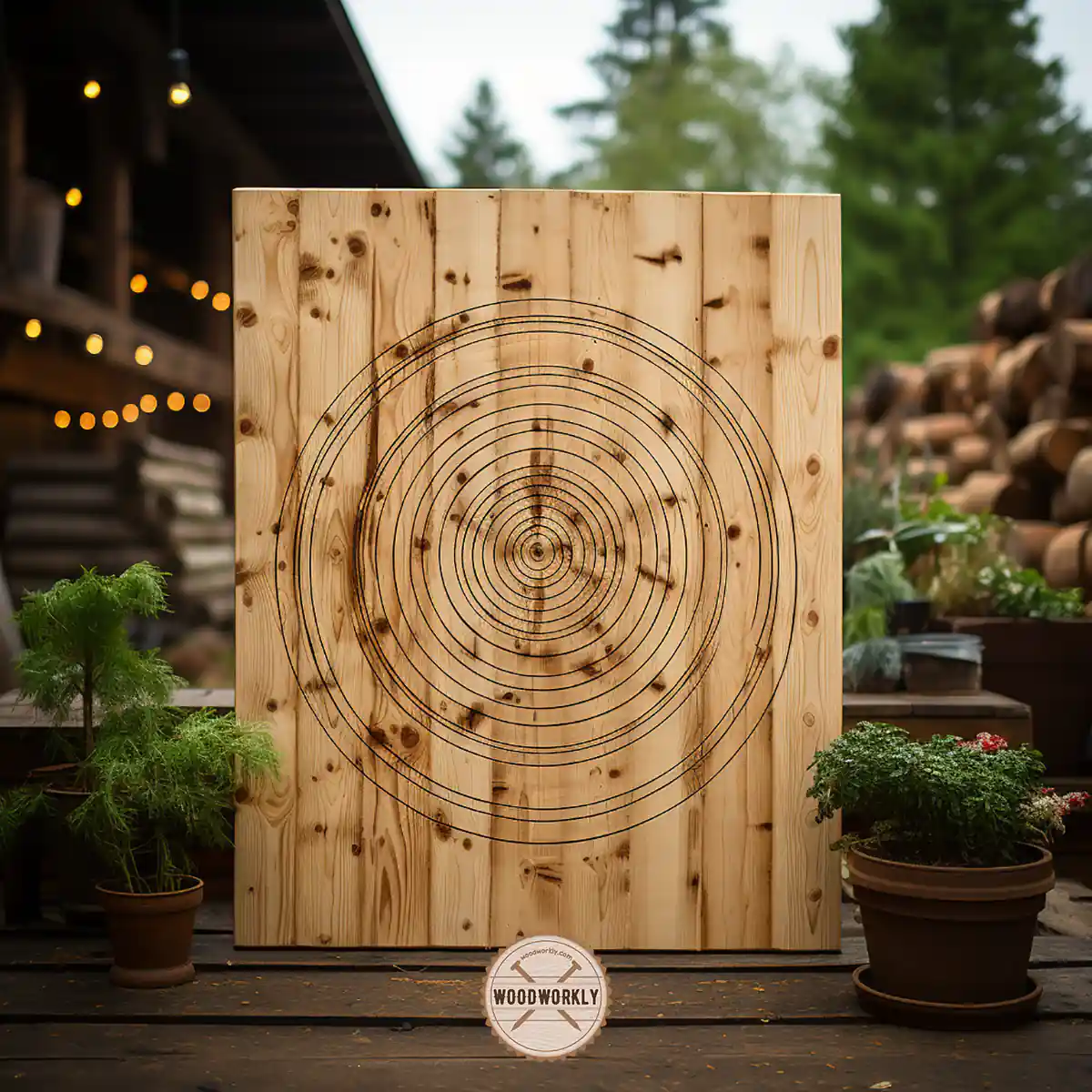
Easy To Work
Pine is considered one of the easiest woods to work with. Therefore, even if you’re a beginner, Pine ais a good wood to go with.
Pine has good screwing and nailing properties which are so useful in woodworking projects.
High Availability
Pinewood is easy to find. It is readily available at many hardwood stores. Therefore finding quality Pinewood is easier and you will be able to practice making axe throwing target using Pinewood.
Strong
Pine has good compressive and bending strength. Therefore, you’ll be able to make a strong and durable axe throwing target using Pine.
Yellow Pine has a compressive strength of 8,470 psi and a bending strength of 14,500 psi.
White Pine has a compressive strength of 4,800 psi and a bending strength of 8,600 psi.
As you can see yellow and white Pine both have pretty good strengths and can use for indoor and outdoor axe throwing target easily.
Durable
Pinewood axe throwing target will easily last for years. Also, Pine boards are thick enough to sustain against repeated throwing.
Pine boards can use under any weather conditions because they’re resistant to shrinking and swelling without cracking.
Pros and Cons of Using Pine Wood For Axe Throwing Target
So, let’s summarize what are the pros and cons of Pine making axe throwing target.
| Pros | Cons |
| High workability | No self-healing or forgiving |
| High availability | Scratch and dent easily |
| Resist to swelling and shrinkage | Tear up easily |
| Has good moisture resistance | |
| Cheap |
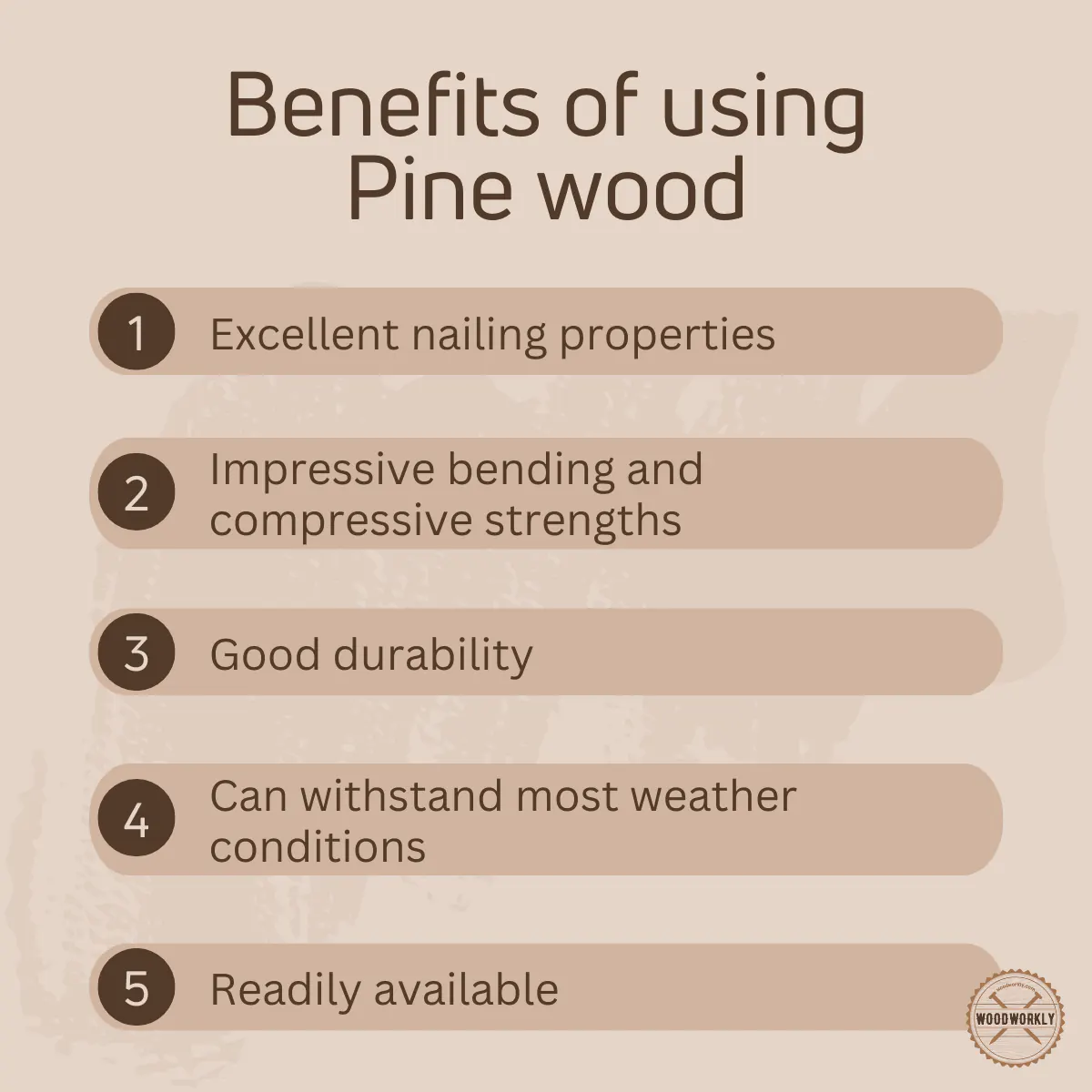
4. Willow
Willow wood is hardwood and resistant to dents and cracks. Therefore, it is so much useful to use as axe throwing target material.
Here’re some qualities of Willow wood that make it perfect for axe throwing targets,
- High workability
- Less noisy
- beautiful appearance
Let’s discuss the above qualities of willow wood in detail.
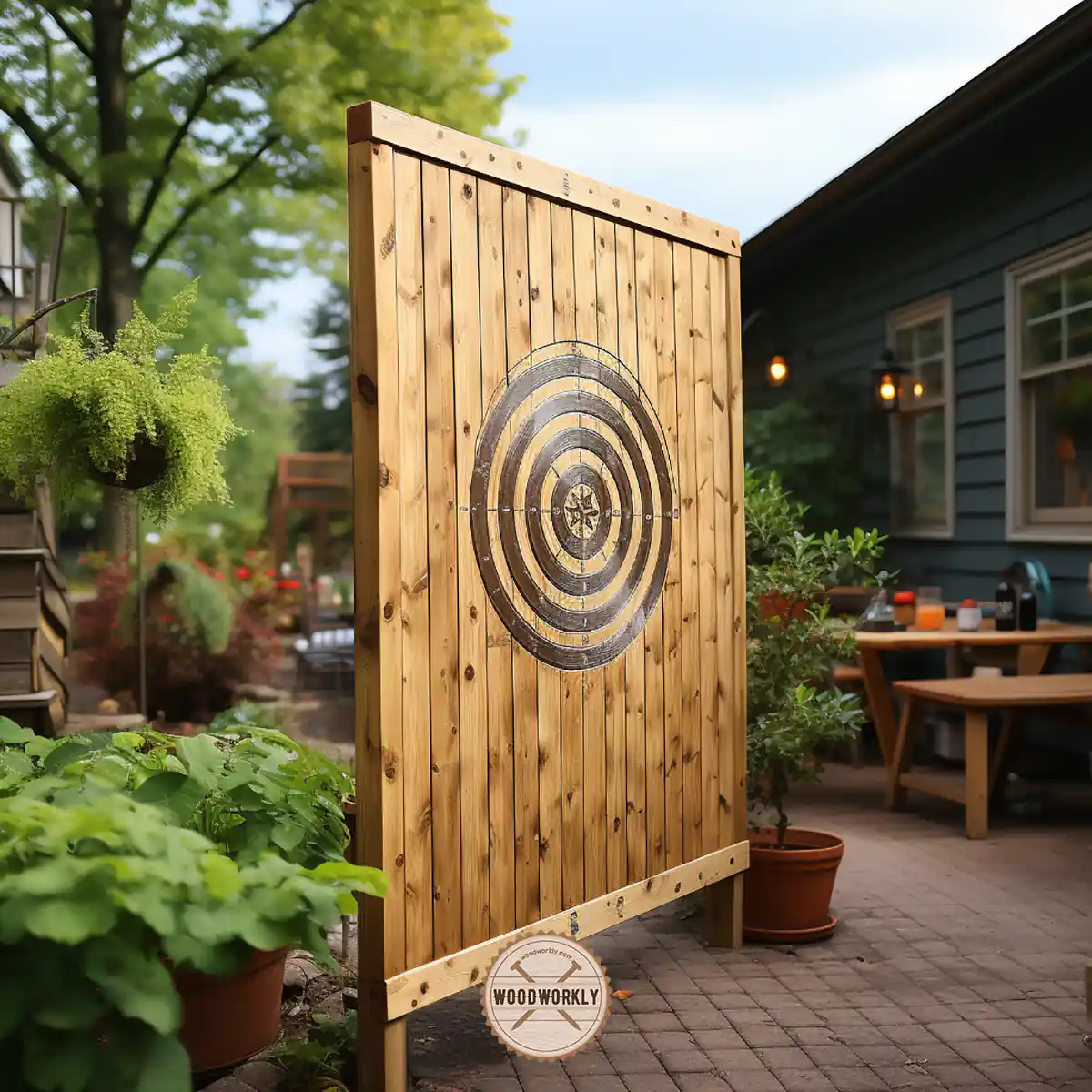
High Workability
It is so much easy to work with Willow because of having straight grain smooth texture. Sanding, painting, and gluing are easy.
Therefore, even a beginner in woodworking can use Willow wood to make an axe throwing target as wished.
Less Noisy
Most of the woods that use for axe throwing targets are noisy and it is a huge disturbance. But Willow wood is a less noisy wood type.
When the axe hits hard, the shock and the noise absorb by the wood itself and release less to the outside world.
Therefore, it is so much easy to keep the concentration steady, because axe throwing needs lots of patience.
Beautiful Appearance
Willow wood has a pinkish-brown beautiful uniform texture that adds a nice unique appearance to the axe throwing target.
The straight wood grain of Willow wood is helpful for finishing the wood because of the high acceptance of wood finishers.
Pros and Cons of Using Willow Wood For Axe Throwing Target
So, let’s highlight some pros and cons of Willow in making axe throwing target.
| Pros | Cons |
| Lightweight | Susceptible to pests |
| High workability | Less durable |
| Not too hard or too soft | No decay resistance |
| Beautiful appearance | |
| Shock resistant | |
| Less noisy | |
| Resistant to dents and cracks |
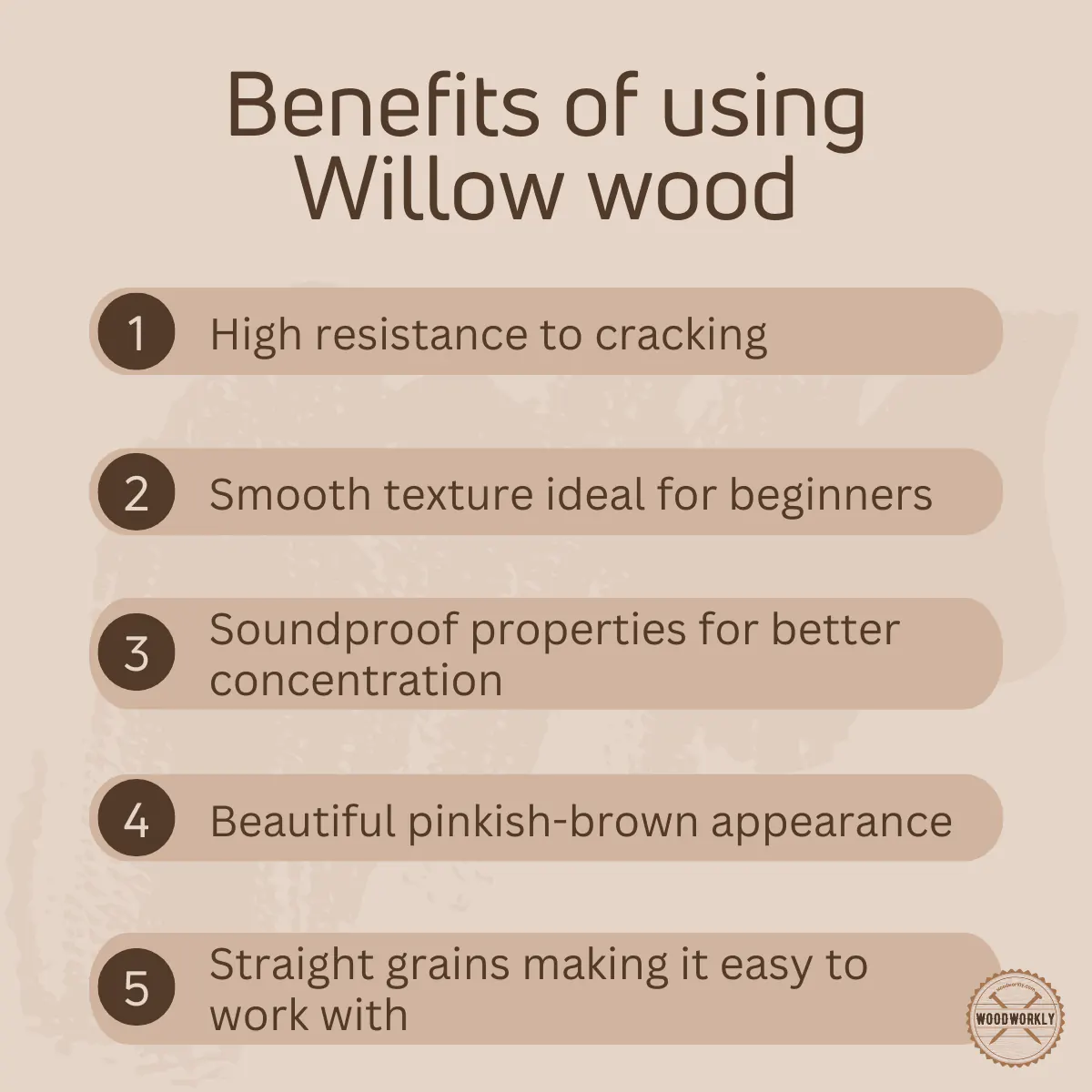
5. Spruce
Spruce is a popular softwood option in axe throwing target material. It softens over time and helps the sharp edges of the axe to reach deep inside the wood with little effort.
Here’re some significant qualities of Spruce for axe throwing target make,
- Axe stick easily
- High workability
- Self-healing wood
- Attractive appearance
- Affordable
Let’s have an in-depth look at those qualities.
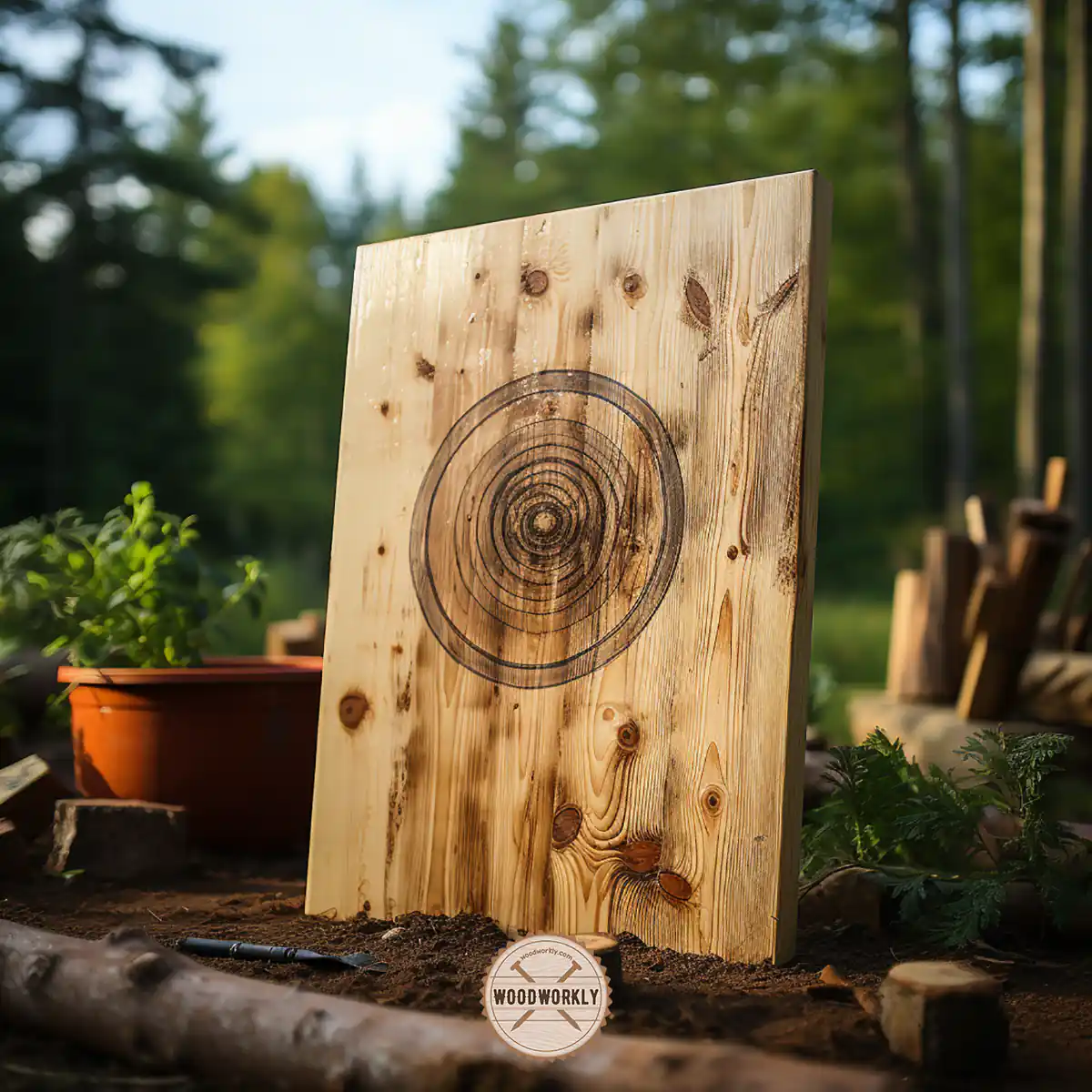
Axe Stick Easily
Spruce is soft enough for an axe’s sharp edge to penetrate through the wood. Therefore, even when the axe is not thrown too forcefully, the axe is able to stick well to the Spruce axe throwing target.
It makes the deeper cut and ensures the axe sticks in the target board on impact.
High Workability
Spruce has very good workability. It is easy to saw and has good nailing properties. It dries easily and does not tend to warp or split.
Therefore, even a beginner in woodworking can use Spruce to make an axe-throwing target.
Self-Healing
When you’re using Spruce wood as a material for axe throwing target, once you pull your axe out the holes will seal up pretty well. This improves the durability of the board, and you can use it for a long time.
It always stays fresh as new because of this self-healing ability which can only be seen in softwoods like Spruce.
Attractive Appearance
Fresh Spruce wood is bright in color. When you use a Spruce axe throwing target for a long time, the color of Spruce changes to reddish-white, and it will be darkened.
This gives a rich aesthetic look to the boards which is so attractive.
Affordable
Spruce is a cheap option for axe throwing target. It is so versatile and more than worth for the price.
Therefore, Spruce is not only used as axe throwing target material but also for many other indoor and outdoor woodworking projects as well.
Pros and Cons of Using Spruce Wood For Axe Throwing Target
So, let’s summarize the pros and cons of Spruce in terms of making axe throwing targets.
| Pros | Cons |
| Axe stick easily | Insect infestations |
| Self-healing | No decay resistance |
| Beautiful appearance | No weather resistance |
| Affordable | |
| Lightweight |
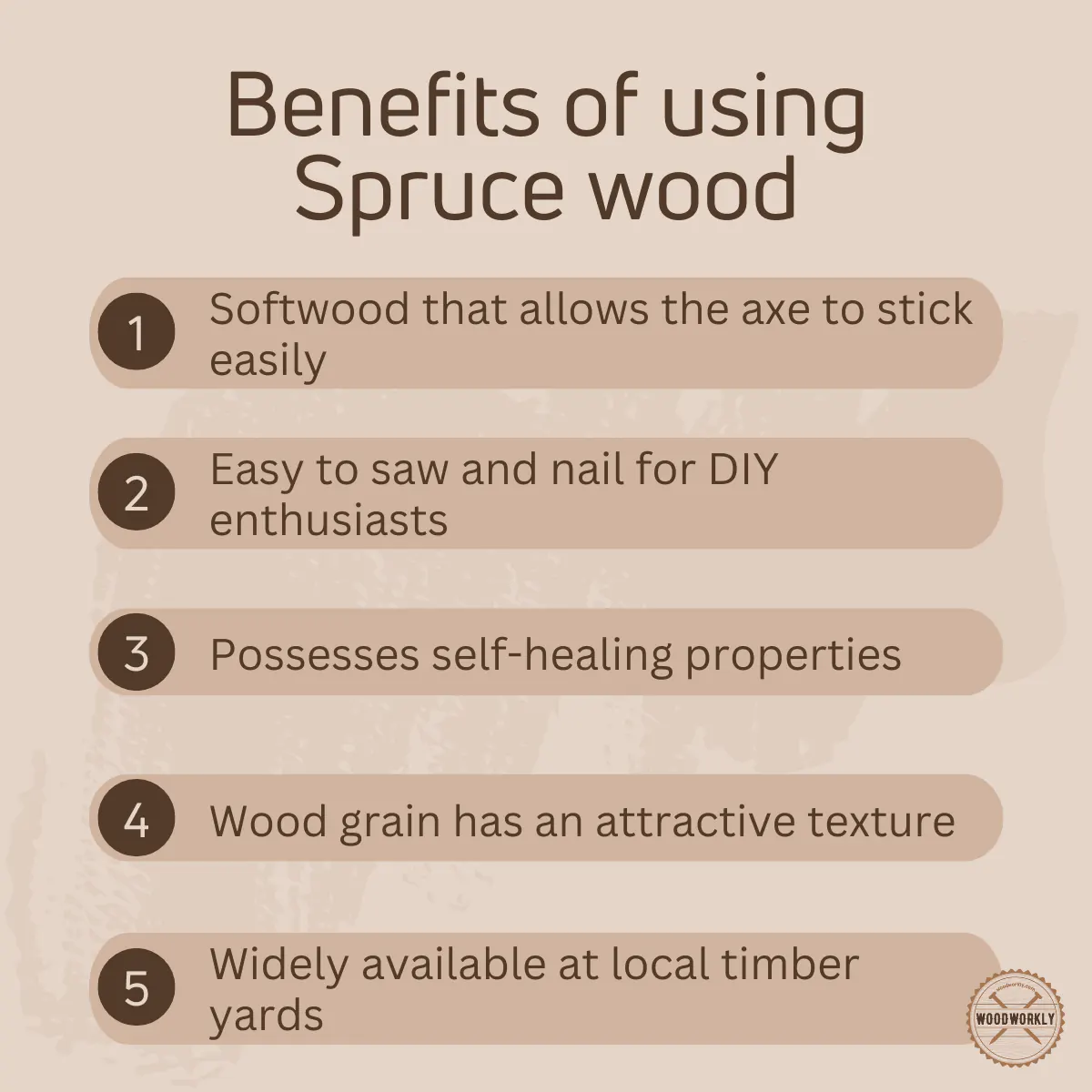
6. Cedar
Cedar is a softwood that is optimal to use as axe throwing target material. It is an aromatic wood with insect-repellant qualities.
The reddish-brown grain adds a unique look to your axe throwing target.
Here’re some significant qualities of Cedar wood that are important in axe-throwing target make.
- High durability
- Lightweight
- High workability
Let’s discuss those qualities in detail.
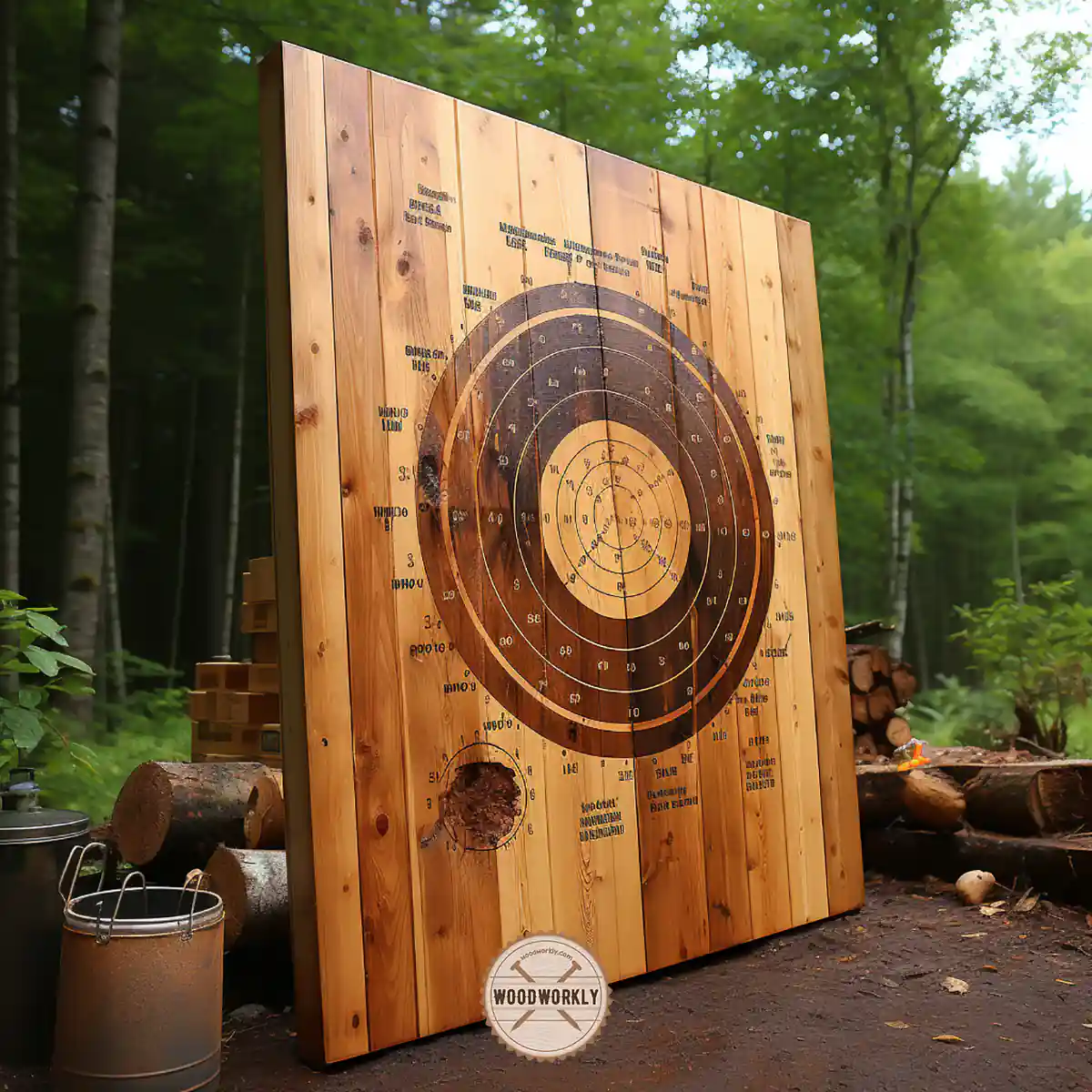
Durability
Cedarwood has high durability which is so useful in making outdoor axe throwing targets. It is resistant to decay, rot and insect attacks, and other environmental elements.
Furthermore, Cedarwood is resistant to moisture, and it does warp easily. Therefore, axe throwing targets made of Cedarwood easily last over years.
Even though most of the softwoods are unable to have good resistance against environmental elements, Cedar has some exceptional qualities for withstanding harsh weather conditions.
This is what Cedar wood makes special.
Lightweight
Axe throwing targets made of Cedar wood can hang on anywhere without any hesitations. It is easy to use at higher altitudes.
High Workability
Cedar wood is easy to work with. It has good finishing properties and is easy to work with big or small machines.
Nailing and screwing are so much easy because of being softwood.
Even a beginner in woodworking can use Cedar wood to make an axe throwing target because of its user-friendliness and meanwhile, you’ll learn lots of woodworking techniques as well.
Pros and Cons Of Using Cedar For Axe Throwing Target
So, let’s summarize the pros and cons of Cedarwood in axe throwing target make.
| Pros | Cons |
| Lightweight | Need High maintenance |
| High workability | Flammable |
| Attractive appearance | Expensive |
| High durability |
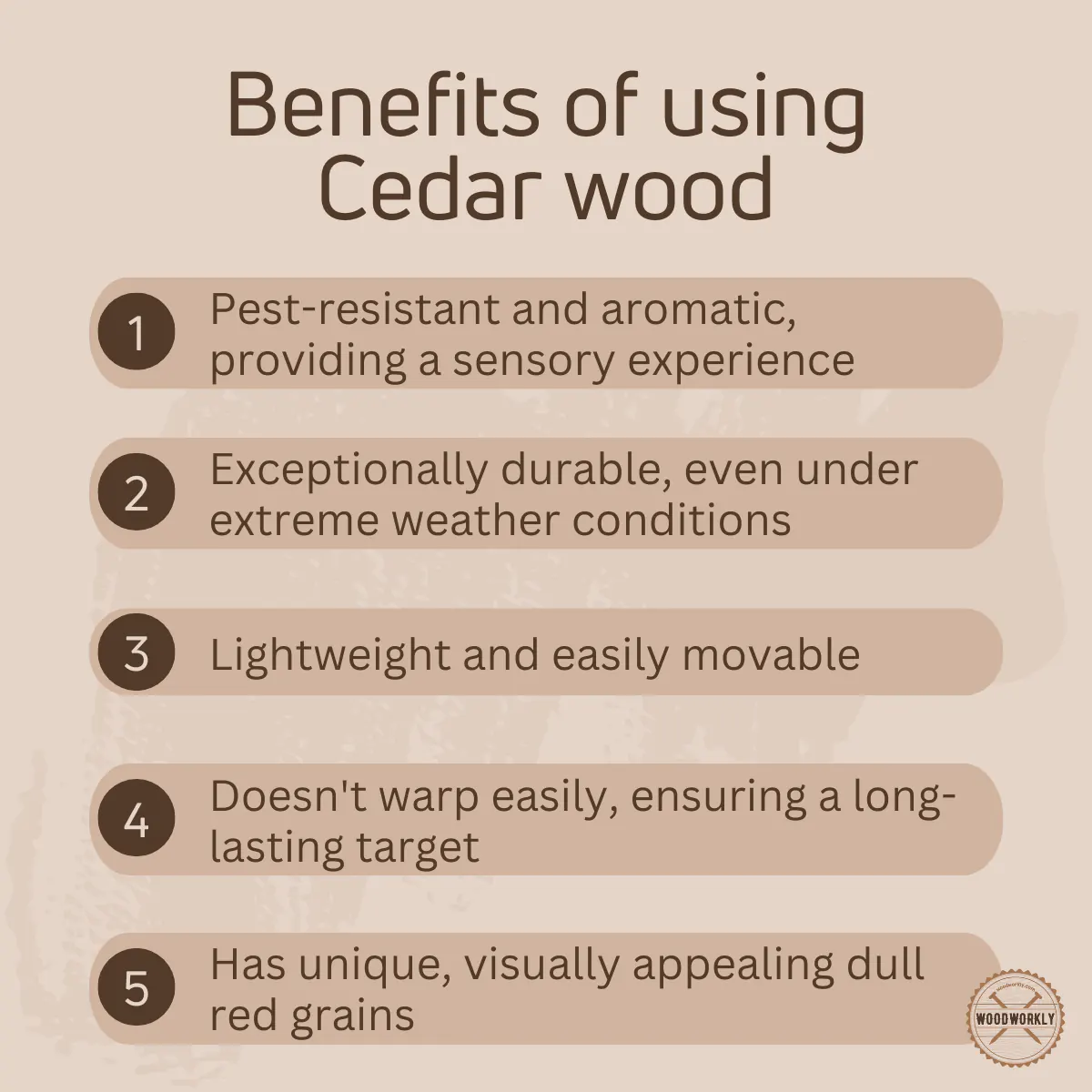
7. Palm
Palm is a great choice for axe throwing target. The tropical appeal f Palm wood adds uniques look to your axe-throwing targets.
So, let’s find out what are the characteristic qualities of Palm wood that are important in axe throwing target,
- Rot resistant wood
- Beautiful appearance
- Lightweight
Let’s discuss those qualities of palm wood in detail which makes it suitable for axe throwing targets.
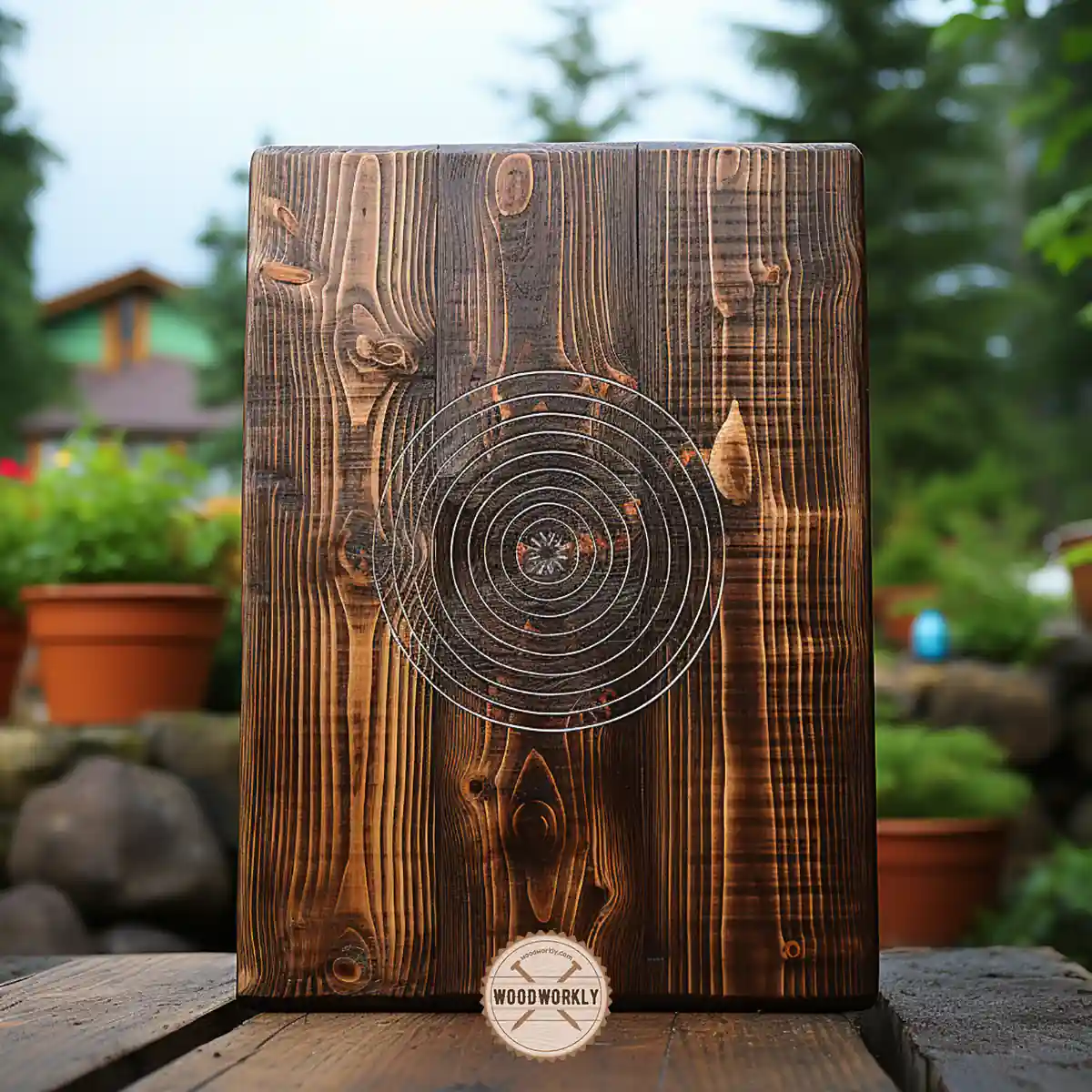
Rot-resistant
Palm wood is hard and low in density. Even though the wood contains a high amount of water molecules and moisture, it cannot destroy the inner structure of the wood.
Therefore, Palm is mostly resistant to rotting and decaying. These significant features and great weather-resistant make Palm wood perfect to build outdoor axe throwing targets.
Beautiful Appearance
Palm wood axe throwing target have a distinct look with a great impression. The natural uniform texture of Palmwood adds unique beauty to the woodwork.
Lightweight
Palm wood is one of the lightest woods on the planet. Therefore, making and handling axe throwing targets made of Palm wood is easy.
The high mobility of Palm wood is great for outdoor axe throwing target-making projects.
Pros and Cons Of Using Palm Wood For Axe Throwing Target
So, let’s summarize the pros and cons of Palm wood in terms of making axe throwing target.
| Pros | Cons |
| Attractive appearance | High maintenance is required |
| Lightweight | Poor weather resistance |
| Uniform wood grain | Poor strength |
| Resistant to termites | Expensive |
| High workability |
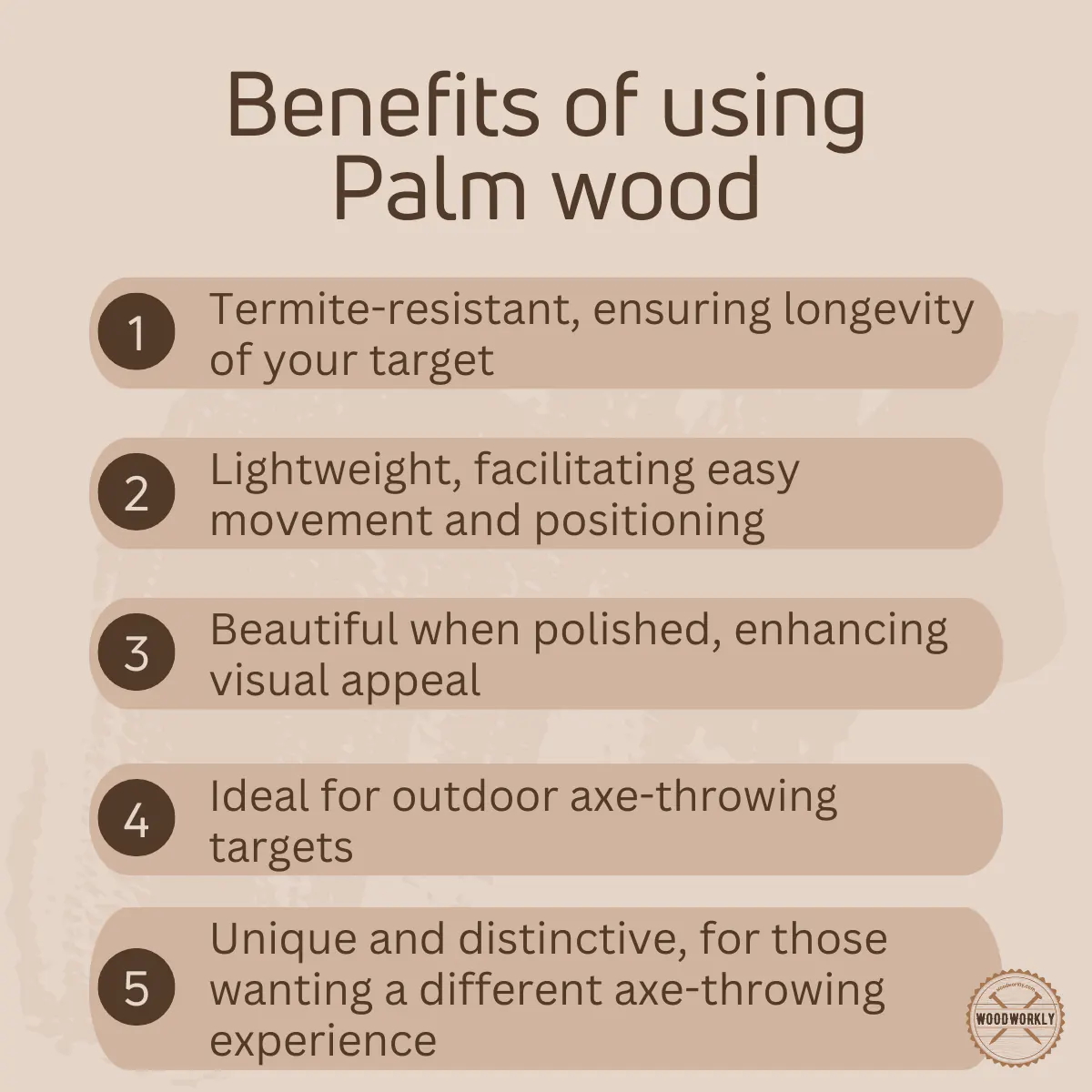
8. Douglas Fir
Douglas Fir is a good choice for an axe throwing target.
Known for its strength and straight grain, Douglas Fir is a type of softwood that’s frequently used for a variety of woodworking projects, including axe throwing targets.
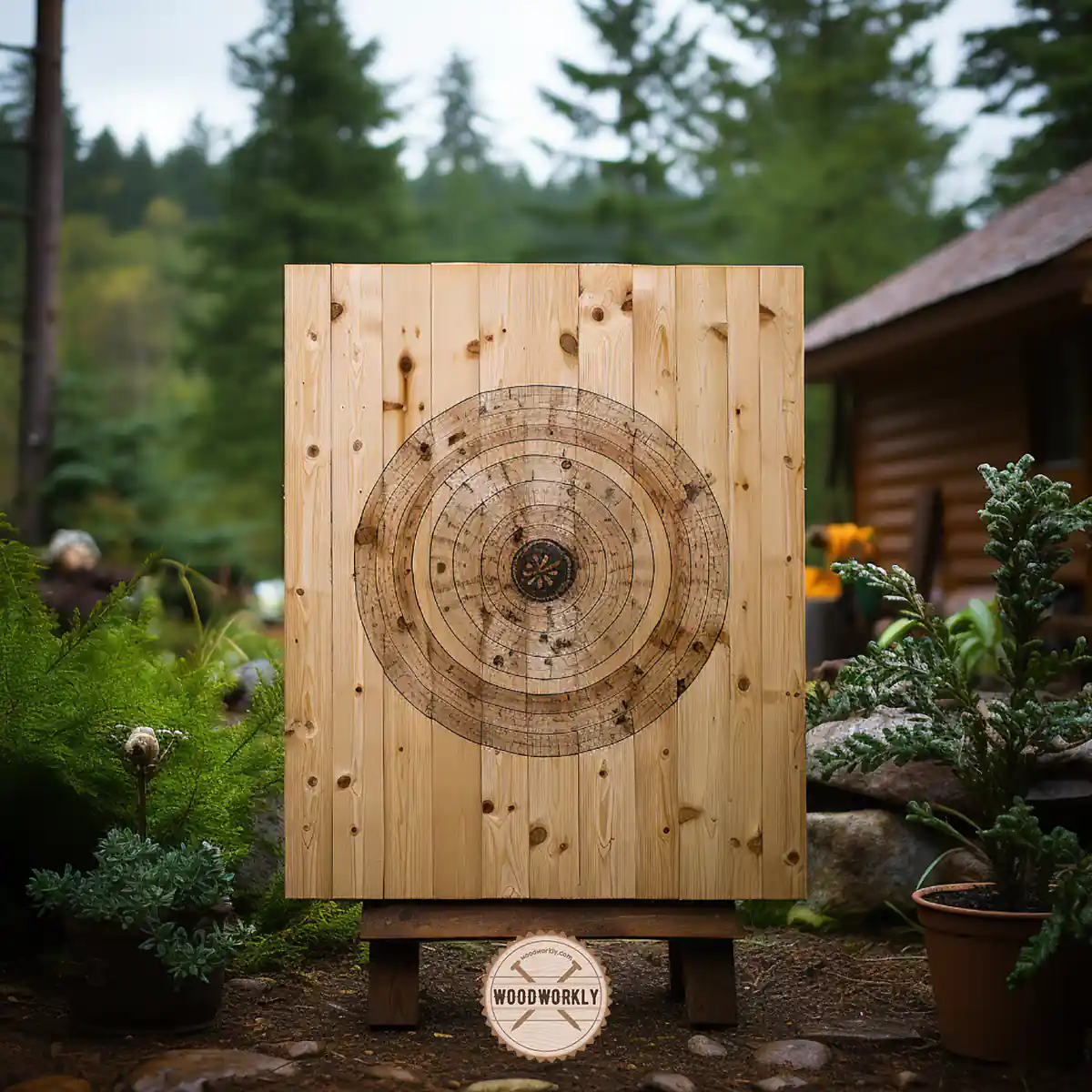
Qualities of Douglas Fir for Axe Throwing Target
- Strength: Douglas Fir is a robust and dense wood, which means it can withstand the force of repeated axe throws. It’s harder than most other types of softwood, making it a durable choice for axe throwing targets.
- Straight Grain: The straight grain of Douglas Fir makes it less likely to split or chip when an axe hits it, which can contribute to the longevity of your target.
- Availability: Douglas Fir is commonly available, making it an accessible choice for your axe throwing target.
- Workability: Due to its straight grain, Douglas Fir is relatively easy to cut and shape, making it a good choice if you want to create a custom-sized axe throwing target.
However, Douglas Fir also has a few downsides. It’s not as resistant to decay as other types of wood, so if you plan on keeping your target outdoors, you’ll need to treat it to prevent rot.
Additionally, while it’s a strong wood, it isn’t as hard as some hardwoods, which means it may not last as long as targets made from woods like Maple or Oak.
Pros and Cons of Using Douglas Fir Wood For Axe Throwing Target
| Pros | Cons |
|---|---|
| Strong and can withstand repeated axe throws | Not as resistant to decay as some other woods |
| Straight grain reduces likelihood of splitting | Not as hard as some hardwoods |
| Widely available | May require treatment for outdoor use |
| Easy to work with for custom target designs | May not last as long as targets made from hardwoods |
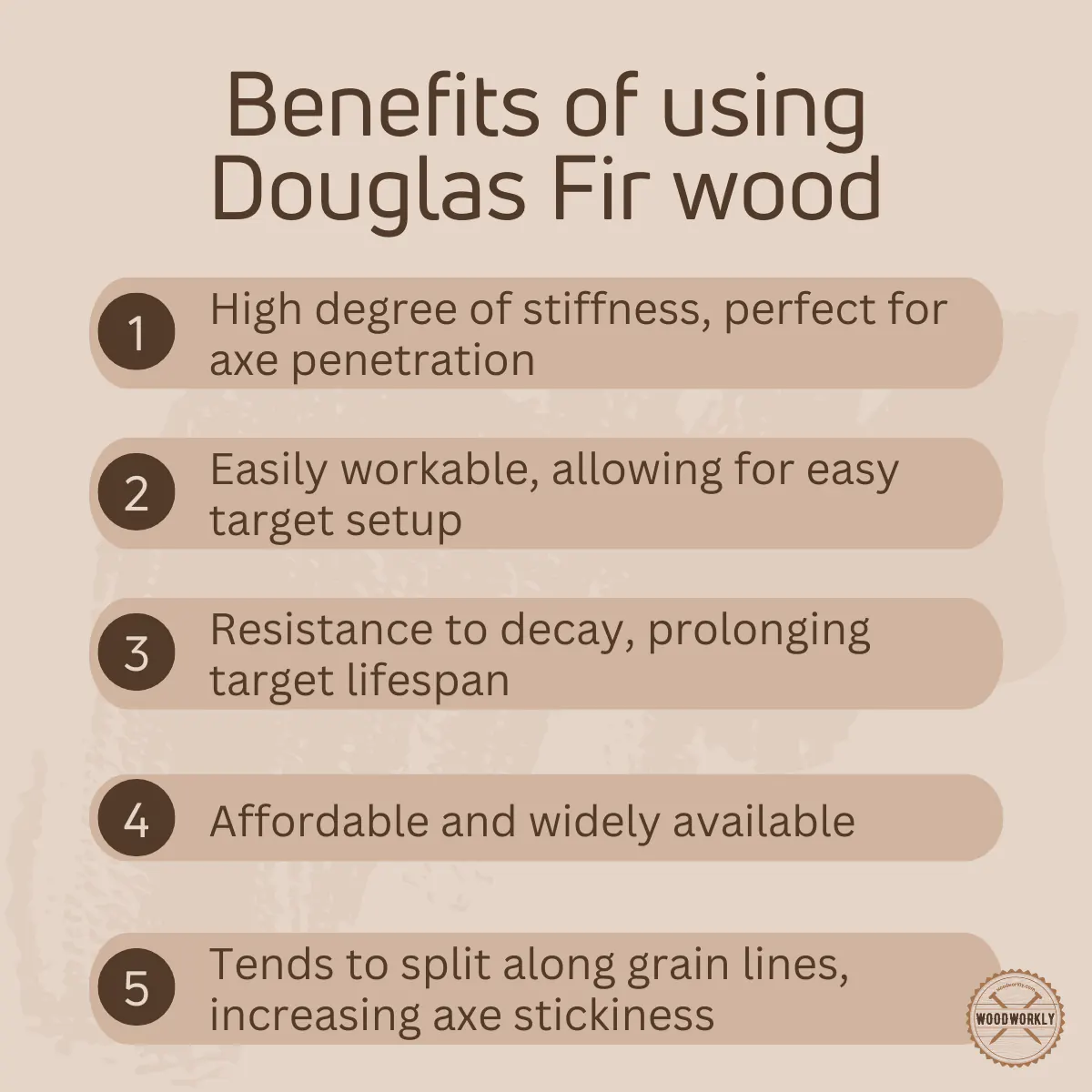
Those are the 8 best wood for axe throwing target with their pros and cons with unique characteristics.
Now I’m going to share with you the factors you need to consider when selecting wood for axe throwing targets using my personal experiences.
Tips for Selecting Wood For Axe Throwing Target
Choosing the right wood for your axe throwing target is not just about picking the first piece of timber you come across.
Several factors should be considered to ensure your axe-throwing experience is both safe and enjoyable.
Let’s discuss some tips to help guide you in this process.
Consider The Wood’s Durability and Resistance
When selecting a wood type for your axe throwing target, durability and resistance are key factors to consider.
These attributes determine how well the target will withstand the impact of the axe and the elements.
Cedar, for instance, is highly durable and can withstand harsh weather conditions.
Similarly, Cottonwood, with its straight grains, is resistant to breaking, making it a solid choice for your target.
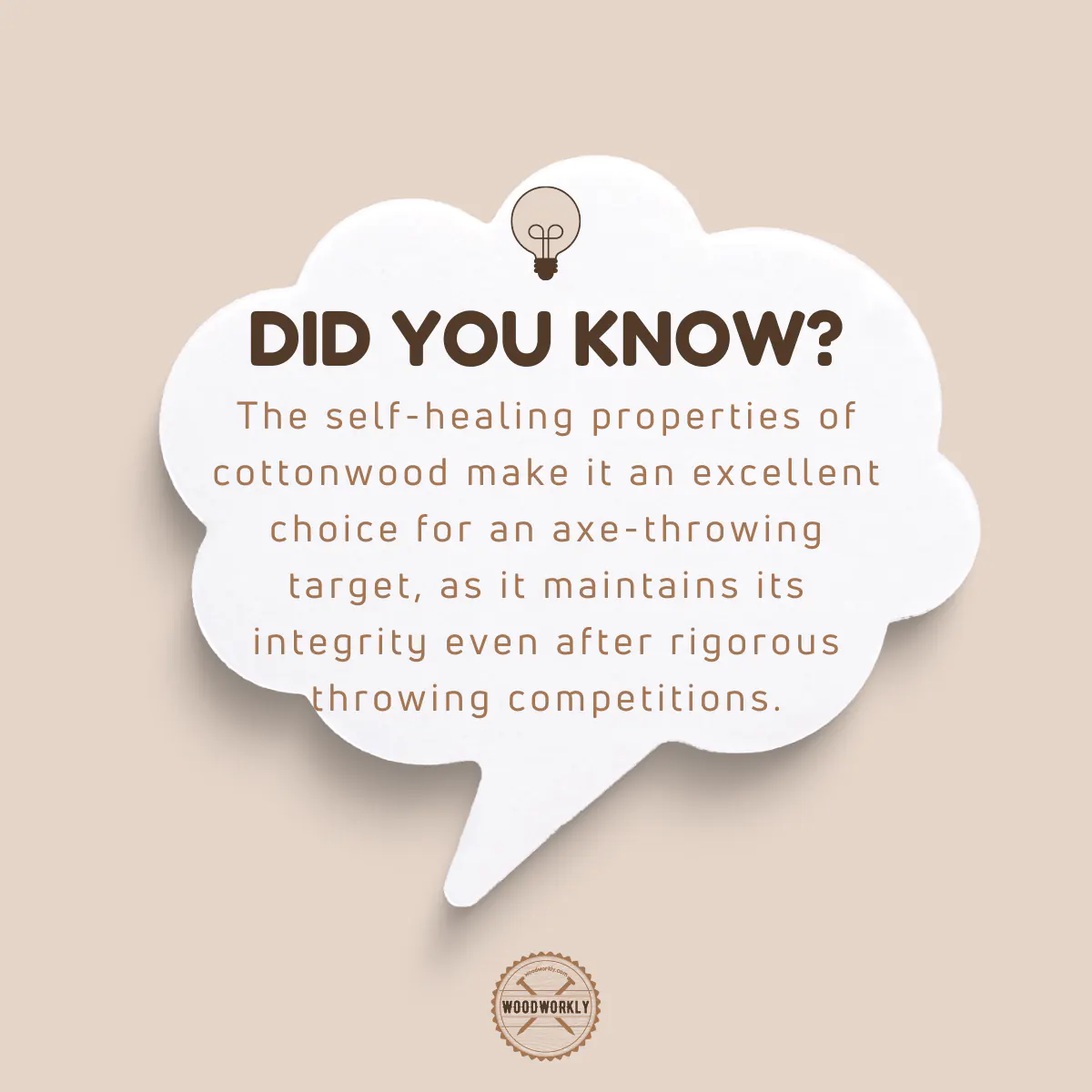
Look for Self-Healing Properties
This might sound like something out of a science fiction novel, but some wood types, like Cottonwood and Poplar, have ‘self-healing’ properties.
Essentially, this means they can recover and close up the dents and cuts made by the axe, prolonging the life of your target.
This is an invaluable feature to consider when choosing your wood.
Consider The Wood’s Availability and Cost
Another crucial aspect to consider is the availability and cost of the wood.
It’s all well and good finding a wood that’s perfect for your needs, but if it’s difficult to source or it breaks the bank, it may not be the best choice.
Pine, for example, is an excellent option for those looking for readily available and cost-effective wood.
Think About The Wood’s Grain Structure
The wood’s grain structure can significantly affect your axe throwing experience.
Ideally, you want wood with straight grains, as it can withstand the axe’s impact better, reducing the likelihood of it breaking apart.
Willow and Cottonwood are excellent examples of woods with straight grains.
Avoid Certain Types of Wood
Not all woods are created equal, and some are simply not suitable for axe throwing targets.
Extremely hard woods, like Maple and Oak, are best avoided as they can be too hard for the axe to penetrate and they lack the self-healing attributes.
Similarly, plywood might seem like a soft and easily available option, but it has a bounce-back effect and can be overly noisy, detracting from your axe-throwing experience.
Consider The Aesthetics
Lastly, while it might not affect your axe-throwing performance, consider the aesthetics of the wood.
After all, your target will likely be a prominent feature in your yard or indoor space.
Woods like Cedar, with its dull red grains, or Willow, with its pinkish-brown appearance, can add a touch of beauty to your setup.
Choosing the best wood for your axe throwing target can greatly enhance your enjoyment of the sport.
Keep these tips in mind when you’re selecting your wood and you’ll have a target that is both practical and pleasing to the eye.
If you’re interested in Axe making, read now the Best Wood for Axe Handle (Expert Picks!)
So, let’s find out what woods you should avoid when making axe throwing target.
Woods To Avoid for Axe Throwing Target
Basically, any wood that is not too hard or not too soft is good to make an axe throwing target.
But particularly there’re 3 wood types you should avoid when making axe throwing targets.
They are,
- Maple
- Oak
- Plywood
So, let’s discuss each of the wood why they’re not suitable for axe throwing target material.
Maple
Maple is considered as a wood you should avoid when making axe throwing target. Maple is too hard with a Janka hardness rating of 1,450 lbf (6,450 N).
Because of being this hard, the axe doesn’t go deep inside of the wood and you need to put high effort to stick the axe on the Maple board.
Maple doesn’t have self-healing properties as softwoods.
Due to those concerns Maple is not the best choice for making axe throwing target.
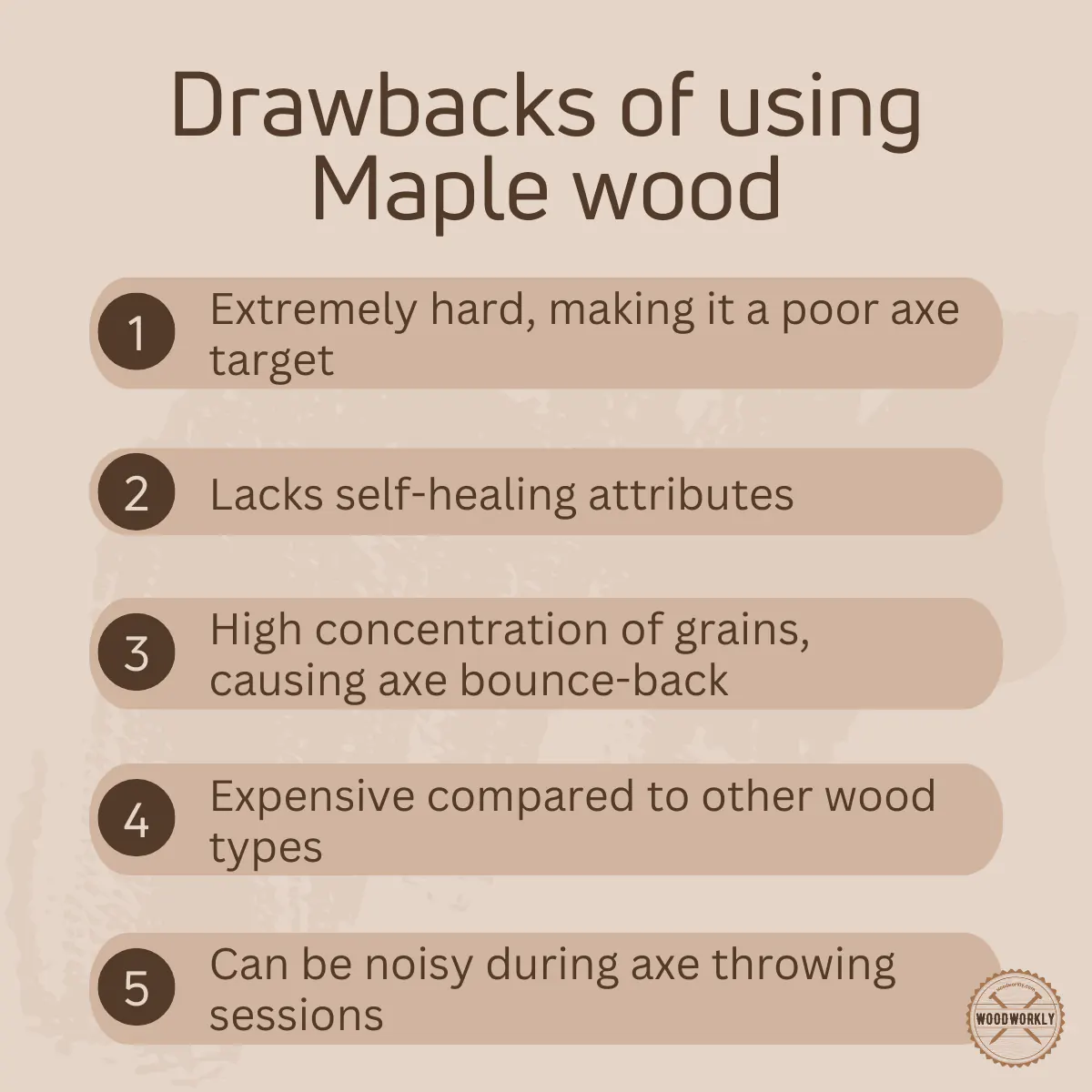
Oak
Oak wood is also a hardwood like Maple which is not suitable for axe throwing target. it has an intense grain pattern.
Therefore, the axe edges cannot go through fibers and make a deep cut.
The workability of Oak wood is also poor because of being extremely hard and dense.
Even though Oak wood is considered great for many woodworking projects, it’s not the best option for axe throwing target material.
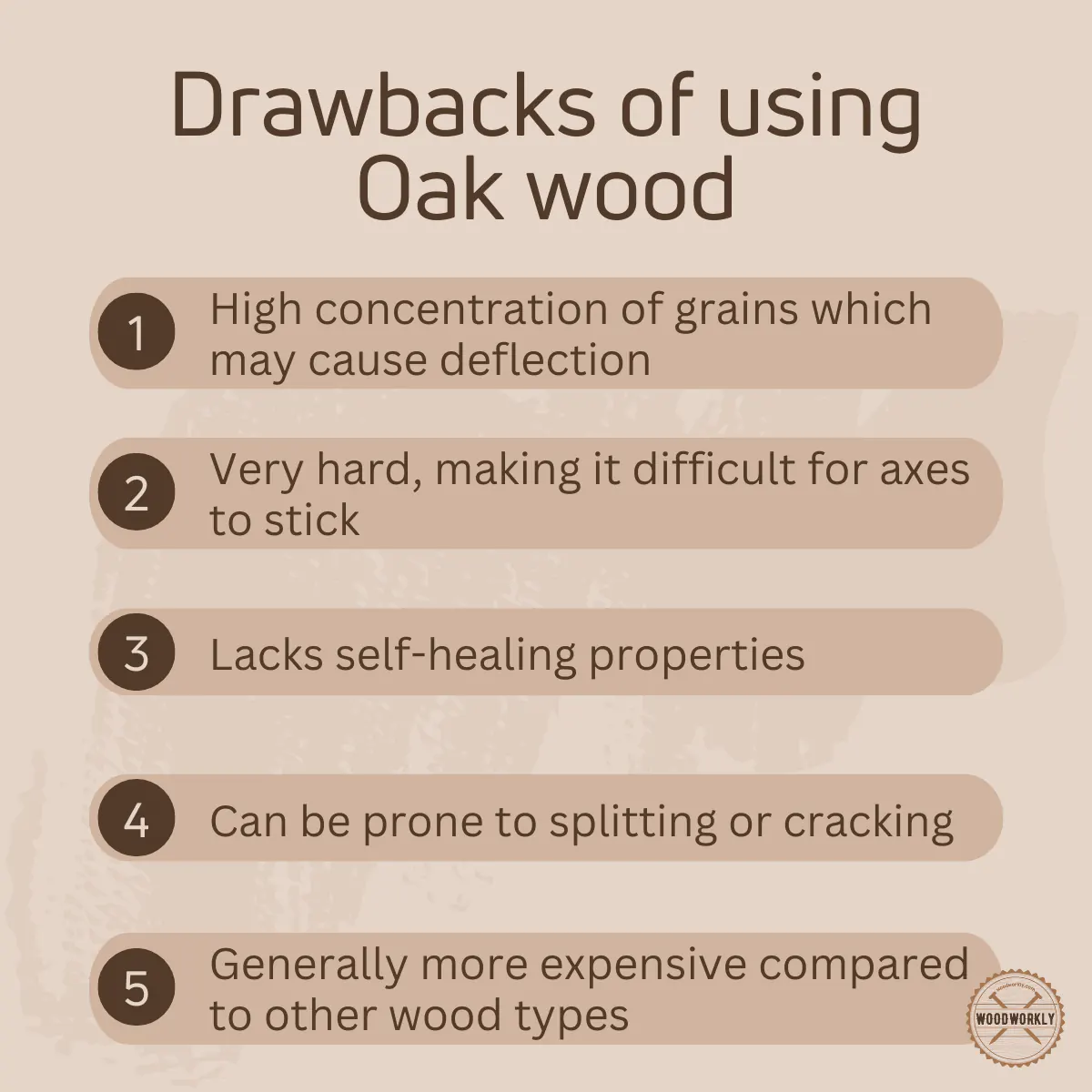
Plywood
Plywood is loud and noisy when getting hit by axe edges. Plywood has a tendency to bounce back, and only heavy axes can go through the Plywood board.
It is made by gluing laminated sheets together. the wood grain is perpendicular, and it is so hard for the axe to make a deep cut and go through the wood fibers.
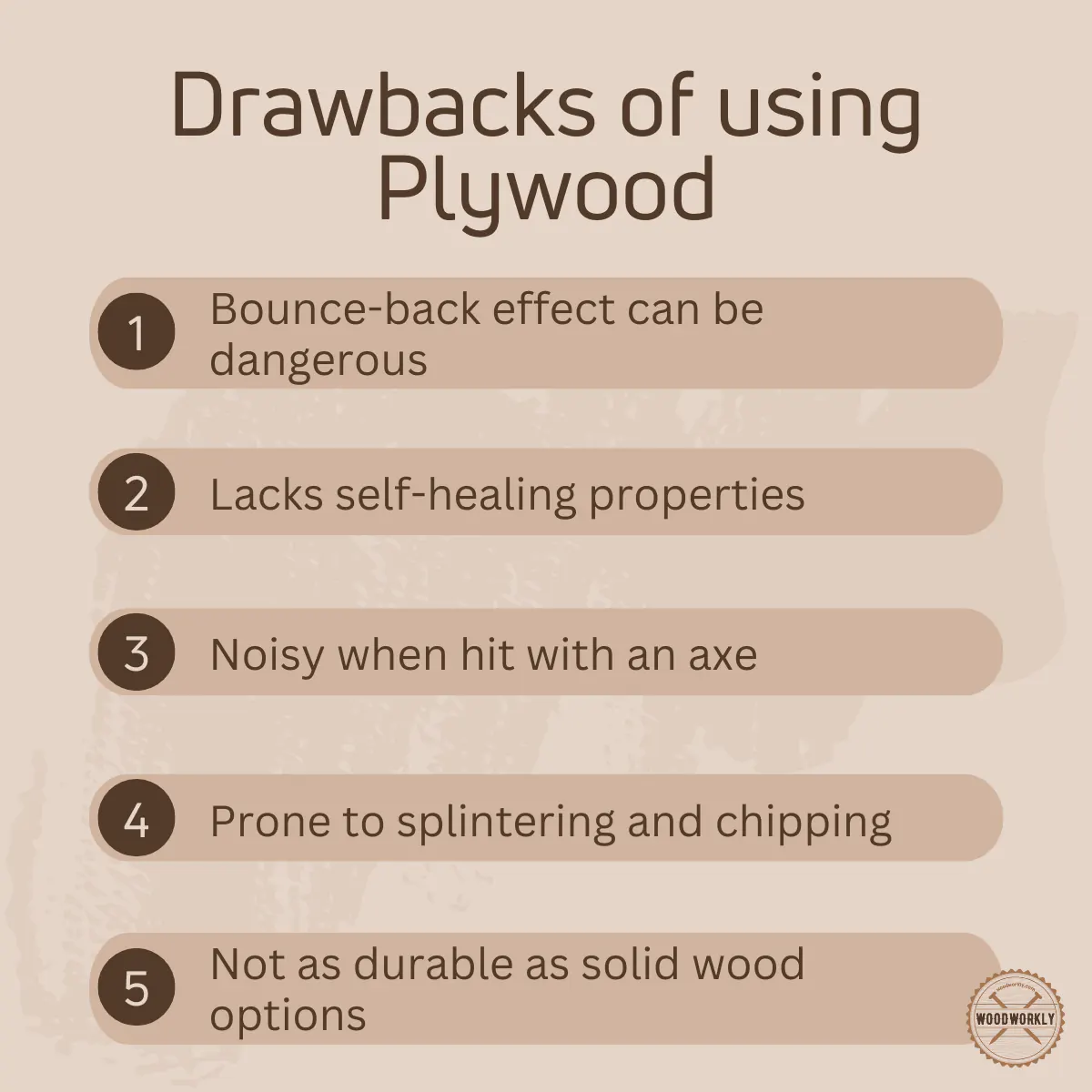
Pressure Treated Wood for Axe Throwing Target?
Pressure treated wood is good to use as axe throwing target material because of having weather resistance, rot, and decay resistance, and is so much better than untreated wood.
The durability of pressure-treated wood is also so much higher than untreated wood.
Understanding Pressure-Treated Wood
First things first, let’s clarify what pressure-treated wood is.
Essentially, this is wood that has undergone a process to improve its durability and resistance to the elements.
The wood is placed under high pressure to infuse it with various chemicals, which protect it from problems like pests, rot, and extreme weather conditions.
The Benefits of Using Pressure-Treated Wood
One of the primary advantages of using pressure-treated wood for an axe-throwing target is its resistance to decay and pests.
This type of wood is treated to withstand harsh elements, making it a good choice if your target is going to be exposed to the outdoors.
Its durability can potentially provide you with a longer-lasting target compared to some other wood types.
Moreover, pressure-treated wood can be more readily available and less expensive than certain types of untreated wood.
This availability and affordability can make it an attractive option, especially if you’re new to axe throwing and are uncertain about investing in more expensive materials.
The Downsides of Using Pressure-Treated Wood
While pressure-treated wood offers some clear advantages, it isn’t without its drawbacks.
One potential issue is the safety concern related to the chemicals used in the pressure treatment process.
Some people worry about the potential health risks that can come from exposure to these chemicals, especially when the wood is cut or sanded, which can release particles into the air.
If you decide to go with pressure-treated wood, make sure to take proper precautions when handling and working with it.
Furthermore, depending on the specific type of pressure-treated wood you choose, it might be harder and more difficult for an axe to penetrate compared to untreated wood or softer woods.
This could potentially affect your axe throwing experience.
The Verdict
So, can you use pressure-treated wood for an axe-throwing target? Absolutely, you can! It’s an especially good option if durability and weather-resistance are high on your priority list.
But it’s essential to consider all factors, including your safety and the throwing experience you’re seeking, before making your final decision.
In the world of axe throwing, there’s no one-size-fits-all solution, and the best choice for you will depend on your unique circumstances and preferences.
Congrats folks! Now you know best wood for axe throwing target with pros and cons of each.
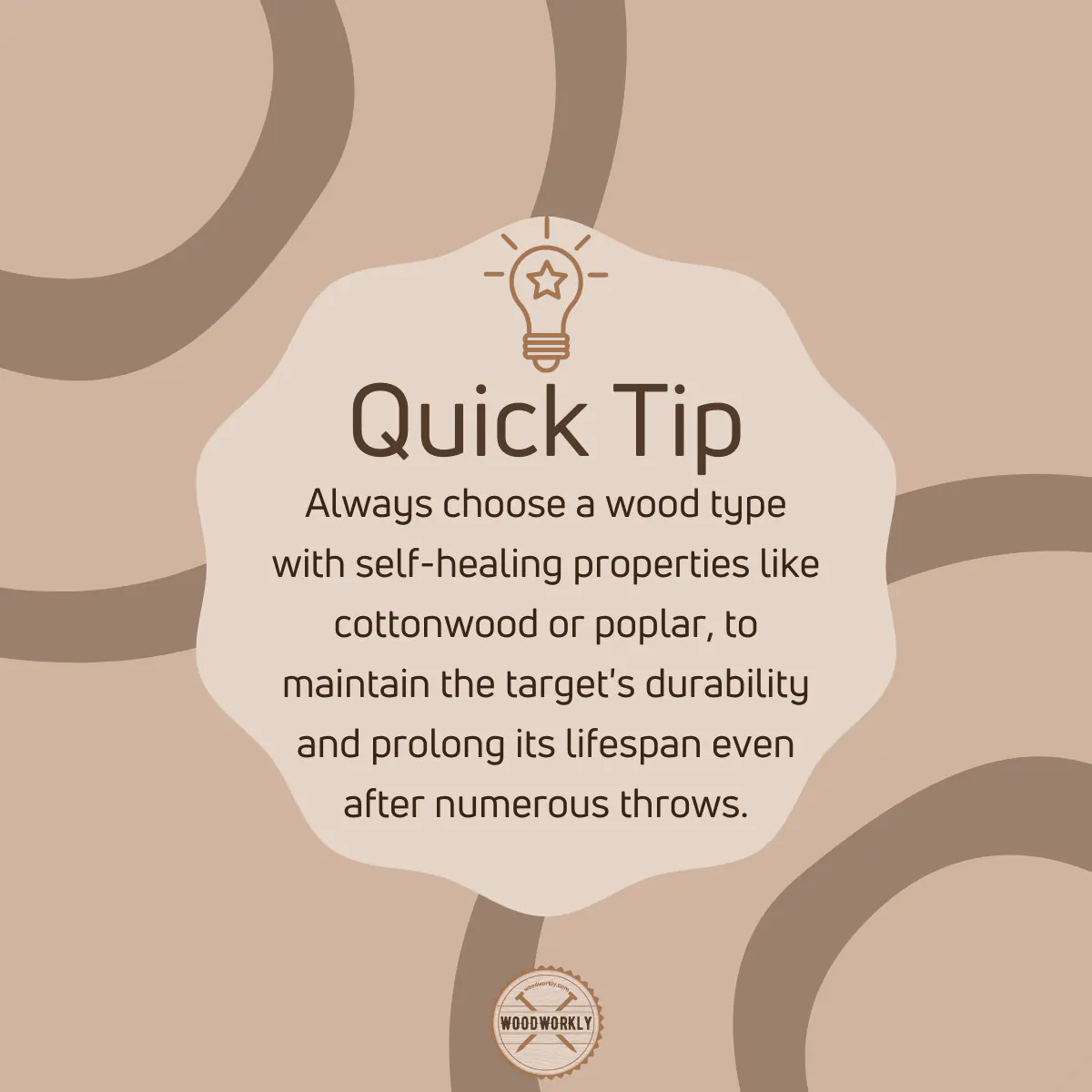
So, let’s answer some frequently asked questions.
FAQs
Why should I avoid using extremely hard woods like maple or oak for an axe-throwing target?
Hard woods like maple and oak tend to lack self-healing attributes and have a high concentration of grains, making it difficult for the axe to penetrate and stick properly, thus reducing the effectiveness of your throwing target.
What is a ‘self-healing’ feature in the context of axe-throwing targets?
‘Self-healing’ refers to a wood’s ability to close up or recover quickly from the holes made by the axe, maintaining the wood’s integrity and extending the life of your axe-throwing target.
Is plywood a good choice for an axe-throwing target?
While plywood is soft, it isn’t recommended for axe-throwing targets because it has a bounce-back effect and can be quite noisy, which could detract from the enjoyment of the activity.
What is the best wood for a knife-throwing target?
Just like with axe-throwing, the ideal wood for a knife-throwing target should be soft enough for the knife to penetrate and stick, but durable enough to withstand repeated throws. Cedar, pine, and poplar are commonly preferred for knife-throwing targets due to their appropriate balance of softness and durability. Cottonwood, with its self-healing properties, is also a top choice as it can maintain its integrity even after many knife strikes.
Did I cover all you wanted to know about: Best Wood for Axe Throwing Target
In this article, I have deeply discussed the 8 best wood for axe throwing target with their qualities.
Furthermore, I’ve explored the advantages and disadvantages of those woods in terms of axe throwing target make.
Also, I’ve discussed about woods that you should avoid when axe throwing target making because of various reasons.
The best woods for axe throwing targets include cedar, pine, cottonwood, willow, poplar, palm, and spruce. Cedar is notable for its durability and aromatic allure, while cottonwood is favored for its self-healing properties. Pine, poplar, and spruce offer a balance of softness and strength, making them excellent choices as well.
According to my experience, any wood that is not too hard or not too soft is ideal to use as axe throwing target material.
Super hard or super softwoods are not good for these types of woodworking projects.
The axe needs to be stick well on top of the board with little effort and self-healing ability is an added advantage of those woods.
Hope you’ve gained good knowledge about the best wood for axe throwing target that you shouldn’t use.
So, let’s begin your next woodworking project of making axe throwing target with correct wood options. Have fun in woodworking!